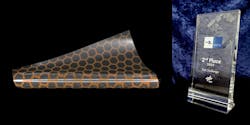A pair of engineers are changing the notion that it’s not practical to monitor aircraft and spacecraft in flight with the installation of measuring probes.
Their innovation, the TOMOPLEX (Tomographic Plexus) sensor film will likely shift that convention with their lightweight, compact and reusable invention. The sensor film, which can be applied to the components of aerospace vehicles as a way to monitor them during flight, has won the second prize award in the international INNOspace Masters competition.
Recipients Alexander Hilgarth and Professor Sergio Montenegro, who hail from the Julius-Maximilians-Universität (JMU) Würzburg in Bavaria, Germany, hope to use their monetary award of about $467,820 (€400,000) towards its first application.
The sensor film can be monitored in real time during flight and is designed to detect material defects that occur only under mechanical stress. For instance, such defects have been observed in composite materials, and may not be detected during inspections, noted the researchers. “One example of this are cracks whose fracture edges rejoin perfectly when unloaded,” explained electrical engineer Hilgarth.
The JMU researchers explained that the sensor film acts as the circuit carrier for a wireless sensor network. The sensor film uses electric impedance tomography, a method for measuring electrical conductivity. This method is uncommon in aerospace, noted the JMU researchers.
Sensor film provides a number of benefits, including reduced costs due to optimized maintenance that is complemented by innovative analysis data. In addition, it makes the reusability of space vehicles more likely. “Only the reusability of carrier systems and components ensures the economic viability of being able to operate space travel in the sense of the New Space,” explained Hilgarth. “However, the possible cost savings are currently still limited by high maintenance costs.”
The term “New Space” refers to recent commercialization of space activities. Space travel used to be the domain of the state, but investments from private firms such as SpaceX, Google, Apple, Facebook and Amazon have increased its footing in the private sector.
The JMU researchers’ innovative entry was among 126 submitted from 23 countries. The submissions were evaluated by 40 experts in a multistage process. Only 15 projects were selected as finalists.
The competition was organized by the German Space Agency at the German Aerospace Center (DLR) on behalf of the Federal Ministry for Economic Affairs and Energy.
A complete list of the projects can be viewed here.


